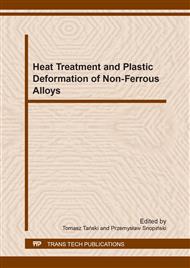p.41
p.53
p.66
p.81
p.89
p.100
p.113
p.124
p.134
Structure, Mechanical Properties and Corrosion Resistance of MgCa5 and MgCa5Zn1 Alloys after Plastic Deformation
Abstract:
Binary Mg-Ca and ternary Mg-Ca-Zn alloys are a new group of magnesium materials, which can be used in many goods. Among others, biomedical applications of these alloys mainly involved surgical implants in the form of plates or screws. In order to improve mechanical properties and corrosion resistance of Mg-based alloys with Ca and Zn addition in as-cast state a plastic deformation was applied by using the KOBO extrusion method. The microstructure studies conducted by scanning microscopy show that the structure of the alloys after the plastic deformation exhibits banding character and the bands are oriented in the direction of an extrusion. A significant increase of mechanical properties was observed for MgCa5Zn1 alloy. After the plastic deformation, the corrosion potential determined for the MgCa5 and MgCa5Zn1 alloy is shifted into the positive direction, which may suggest the increase of corrosion resistance. Moreover, the MgCa5 alloy in as-cast state was completely dissolved after 288 h of immersion in Ringer’s solution. A volume of hydrogen evolution for the same alloy after plastic deformation showed a value of 35 ml/cm2.
Info:
Periodical:
Pages:
124-133
Citation:
Online since:
June 2018
Authors:
Price:
Сopyright:
© 2018 Trans Tech Publications Ltd. All Rights Reserved
Share:
Citation:



